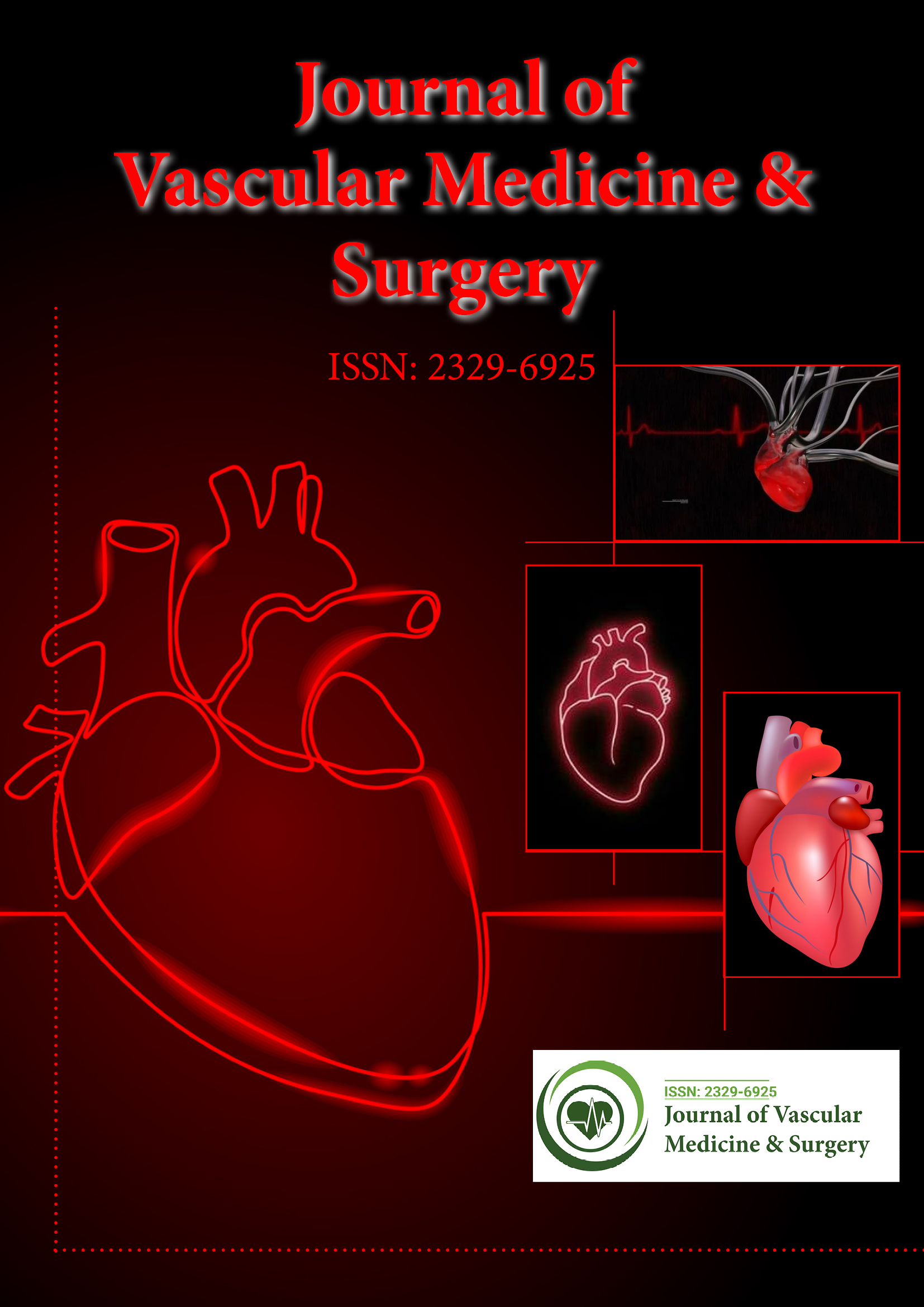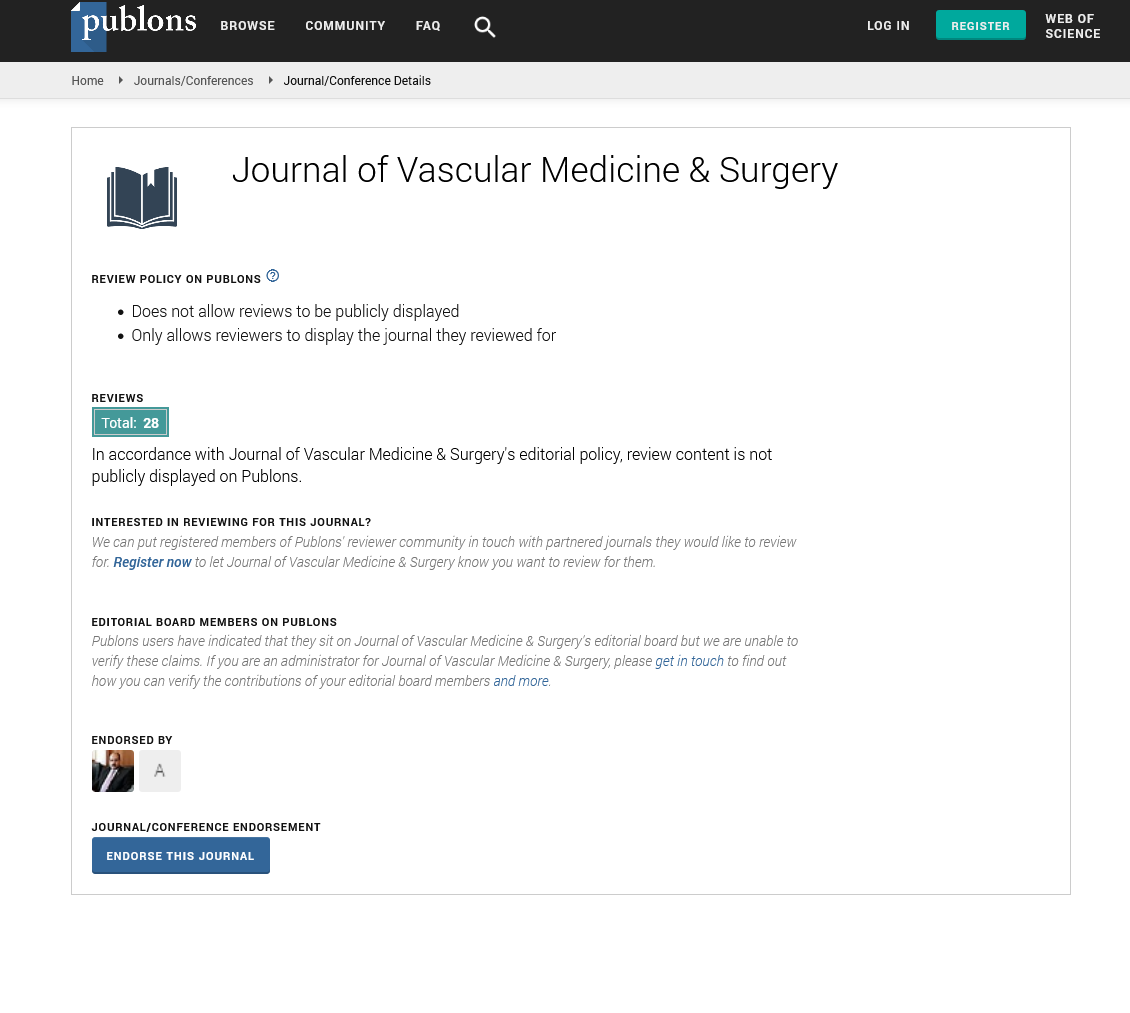Indexed In
- Open J Gate
- Academic Keys
- RefSeek
- Hamdard University
- EBSCO A-Z
- OCLC- WorldCat
- Publons
- Euro Pub
- Google Scholar
- SHERPA ROMEO
Useful Links
Share This Page
Journal Flyer

Open Access Journals
- Agri and Aquaculture
- Biochemistry
- Bioinformatics & Systems Biology
- Business & Management
- Chemistry
- Clinical Sciences
- Engineering
- Food & Nutrition
- General Science
- Genetics & Molecular Biology
- Immunology & Microbiology
- Medical Sciences
- Neuroscience & Psychology
- Nursing & Health Care
- Pharmaceutical Sciences
Commentary - (2024) Volume 12, Issue 4
The Importance of Blood Pressure Management in the Prevention of Aneurysms by Surgical and Medical Imaging Methods
Caitlin Julia*Received: 24-Jun-2024, Manuscript No. JVMS-24-26696; Editor assigned: 27-Jun-2024, Pre QC No. JVMS-24-26696 (PQ); Reviewed: 11-Jul-2024, QC No. JVMS-24-26696; Revised: 18-Jul-2024, Manuscript No. JVMS-24-26696 (R); Published: 25-Jul-2024, DOI: 10.35248/2329-6925.24.12.562
Description
A localized swelling of a blood vessel caused by a weakening of the vessel wall is known as an aneurysm. Although this type of disorder can affect any blood vessel, and arteries, especially the aorta and blood vessels in the brain are the most frequently affected. Because aneurysms can burst and produce potentially fatal internal bleeding, they offer serious health risks. Brain aneurysms, also referred to as cerebral aneurysms, develop in the brain's blood vessels and, in the event that they burst, may cause a hemorrhagic stroke. A number of conditions that weaken the walls of blood vessels can cause aneurysms. Chronically high blood pressure, or hypertension, can weaken arterial walls by applying excessive force to them. Aneurysms can be predisposed in people with conditions such polycystic kidney disease, Ehlers- Danlos syndrome, and Marfan syndrome. As people get older, there is an increased risk of having an aneurysm, with men often being more at risk than women. An important risk factor for aneurysms, especially abdominal aortic aneurysms, is tobacco use. Aneurysm formation may be facilitated by direct trauma to blood vessels or infections such as syphilis. Aneurysms are more common in families where there is a history of the illness.
Aneurysms are frequently found by error during imaging testing for unrelated illnesses, even though many of them are asymptomatic. On the other hand, symptoms could manifest according on the size, location, and rupture status of the aneurysm. A deep, continuous ache in the abdomen or back, as well as likely leg pain, might be symptoms of an Abdominal Aortic Aneurysm (AAA). Inability to breathe, coughing, fainting, chest pain, and back pain are all possible symptoms of a Thoracic Aortic Aneurysm (TAA). Brain aneurysms are frequently asymptomatic until they burst, at the point when they may produce abrupt, excruciating headaches, nausea, blurred vision, unconsciousness, and neurological impairments. Chest pain, exhaustion, and shortness of breath are heart failure symptoms that can be brought on by a ventricular aneurysm. Aneurysm rupture is the main risk factor since it can cause serious internal bleeding, shock, and even death. Pressing adjacent structures and enlarging aneurysms can cause symptoms including pain or decreased organ function. Imaging tests are commonly used to diagnose an aneurysm in order to view the blood vessels and determine the size and location of the aneurysm. Finding abdominal aortic aneurysms is frequently accomplished by ultrasound.
A CT scan can detect aneurysms in a variety of places and offers detailed images. High-resolution blood vessel pictures are provided by MRI, which is helpful in diagnosing thoracic and brain aneurysms. In order to emphasize blood vessels on X-rays, angiography entails injecting a contrast dye into the bloodstream. Aneurysms are managed according to their size, location, and rupture. Options for treatment include both surgical intervention and monitoring. Imaging tests can be used to examine small aneurysms that are not generating symptoms on a regular basis to assess for growth. Medication that lowers blood pressure can lessen the chance of aneurysm rupture and growth. A stent-graft is introduced through the blood vessels during endovascular repair, a minimally invasive treatment, to strengthen the aneurysm wall and stop it from rupturing.
During open surgery, the damaged artery is excised and replaced with a synthetic graft. This is frequently required for significant or symptomatic aneurysms. Although aneurysms cannot always be prevented, there are lifestyle modifications and medical procedures that can lower the risk. Reducing the stress on artery walls can be achieved by controlling hypertension with medicine, diet, and exercise. Tobacco usage must be avoided in order to stop aneurysm formation and progression. A healthy diet low in cholesterol and saturated fats can help avoid atherosclerosis. Regular imaging studies and physical examinations can be helpful in the early detection of aneurysms, especially in those with medical conditions. Because aneurysms run the risk of rupturing and developing serious problems, they are a vital vascular condition that needs to be carefully monitored and managed. Understanding the many kinds, origins, indications, and therapies available for aneurysms is critical for efficient prevention and management. Patients with aneurysms now have much better prognoses due to advances in medical imaging and surgery methods. However, reducing the risk of aneurysms and guaranteeing prompt medical attention still depend heavily on lifestyle changes and routine health examinations.
Citation: Julia C (2024) The Importance of Blood Pressure Management in the Prevention of Aneurysms by Surgical and Medical Imaging Methods. J Vasc Surg. 12:562
Copyright: © 2024 Julia C. This is an open-access article distributed under the terms of the Creative Commons Attribution License, which permits unrestricted use, distribution, and reproduction in any medium, provided the original author and source are credited.

